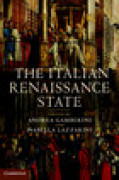
A magisterial account of Renaissance Italy's political history and its contribution to the evolution of a European political identity. This magisterial study offers a revised account of the complex political history of Renaissance Italy. Its team of leading international scholars reinvigorates the place of politics in Renaissance historiography, identifying the period as a pivotal moment in the history of the state in Europe. This magisterial study offers a revised account of the complex political history of Renaissance Italy. Its team of leading international scholars reinvigorates the place of politics in Renaissance historiography, identifying the period as a pivotal moment in the history of the state in Europe. This magisterial study proposes a revised and innovative view of the political history of Renaissance Italy. Drawing on comparative examples from across the peninsula and the kingdoms of Sicily, Sardinia and Corsica, an international team of leading scholars highlights the complexity and variety of the Italian world from the fourteenth to early sixteenth centuries, surveying the mosaic of kingdoms, principalities, signorie and republics against a backdrop of wider political themes common to all types of state in the period. The authors address the contentious problem of the apparent weaknessof the Italian Renaissance political system. By repositioning the Renaissanceas a political, rather than simply an artistic and cultural phenomenon, they identify the period as a pivotal moment in the history of the state, in which political languages, practices and tools, together with political and governmental institutions, became vital to the evolution of a modern European political identity. INDICE: Introduction Andrea Gamberini and Isabella Lazzarini; Part I. The Italian States: 1. The Kingdom of Sicily Fabrizio Titone; 2. The Kingdom of Naples Francesco Senatore; 3. The Kingdom of Sardinia and Corsica Olivetta Schena; 4. The papal state Sandro Carocci; 5. Tuscan states: Florence and Siena Lorenzo Tanzini; 6. Ferrara and Mantua Trevor Dean; 7. Venice and the Terraferma Michael Knapton; 8. Lombardy under the Visconti and the Sforza Federico Del Tredici; 9. The feudal principalities: the west (Monferrato, Saluzzo, Savoy, Savoy-Acaia) Alessandro Barbero; 10. The feudal principalities: the east (Trent, Bressanone/Brixen, Aquileia, Tyrol and Gorizia) Marco Bellabarba; 11. Genoa, Christine Shaw; Part II. Themes and Perspectives: 12. The collapse of city-states and the role of urban centres in the new political geography of RenaissanceItaly Francesco Somaini; 13. The rural communities Massimo Della Misericordia; 14. Lordships, fiefs 'small states' Federica Cengarle; 15. Factions and parties: problems and perspectives Marco Gentile; 16. State, orders and social distinction E. Igor Mineo; 17. Women and the state Serena Ferente; 18. Offices and officials Guido Castelnuovo; 19. Public written records Gian Maria Varanini;20. The language of politics and the process of statebuilding: approaches andinterpretations Andrea Gamberini; 21. Renaissance diplomacy Isabella Lazzarini; 22. Regional states and economic development Franco Franceschi and Luca MolÃá; 23. The papacy and the Italian states Giorgio Chittolini; 24. Justice Andrea Zorzi; Bibliography.
- ISBN: 978-1-107-01012-3
- Editorial: Cambridge University
- Encuadernacion: Cartoné
- Páginas: 648
- Fecha Publicación: 29/03/2012
- Nº Volúmenes: 1
- Idioma: Inglés
